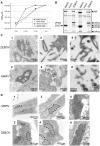Establishment of fruit bat cells (Rousettus aegyptiacus) as a model system for the investigation of filoviral infection
- PMID: 20808767
- PMCID: PMC2927428
- DOI: 10.1371/journal.pntd.0000802
Establishment of fruit bat cells (Rousettus aegyptiacus) as a model system for the investigation of filoviral infection
Abstract
Background: The fruit bat species Rousettus aegyptiacus was identified as a potential reservoir for the highly pathogenic filovirus Marburg virus. To establish a basis for a molecular understanding of the biology of filoviruses in the reservoir host, we have adapted a set of molecular tools for investigation of filovirus replication in a recently developed cell line, R06E, derived from the species Rousettus aegyptiacus.
Methodology/principal findings: Upon infection with Ebola or Marburg viruses, R06E cells produced viral titers comparable to VeroE6 cells, as shown by TCID(50) analysis. Electron microscopic analysis of infected cells revealed morphological signs of filovirus infection as described for human- and monkey-derived cell lines. Using R06E cells, we detected an unusually high amount of intracellular viral proteins, which correlated with the accumulation of high numbers of filoviral nucleocapsids in the cytoplasm. We established protocols to produce Marburg infectious virus-like particles from R06E cells, which were then used to infect naïve target cells to investigate primary transcription. This was not possible with other cell lines previously tested. Moreover, we established protocols to reliably rescue recombinant Marburg viruses from R06E cells.
Conclusion/significance: These data indicated that R06E cells are highly suitable to investigate the biology of filoviruses in cells derived from their presumed reservoir.
Conflict of interest statement
The authors have declared that no competing interests exist.
Figures




Similar articles
-
Authentication of the R06E fruit bat cell line.Viruses. 2012 May;4(5):889-900. doi: 10.3390/v4050889. Epub 2012 May 23. Viruses. 2012. PMID: 22754654 Free PMC article.
-
Innate Immune Responses of Bat and Human Cells to Filoviruses: Commonalities and Distinctions.J Virol. 2017 Mar 29;91(8):e02471-16. doi: 10.1128/JVI.02471-16. Print 2017 Apr 15. J Virol. 2017. PMID: 28122983 Free PMC article.
-
Experimental Inoculation of Egyptian Rousette Bats (Rousettus aegyptiacus) with Viruses of the Ebolavirus and Marburgvirus Genera.Viruses. 2015 Jun 25;7(7):3420-42. doi: 10.3390/v7072779. Viruses. 2015. PMID: 26120867 Free PMC article.
-
Tissue and cellular tropism, pathology and pathogenesis of Ebola and Marburg viruses.J Pathol. 2015 Jan;235(2):153-74. doi: 10.1002/path.4456. J Pathol. 2015. PMID: 25297522 Review.
-
Standardization of the filovirus plaque assay for use in preclinical studies.Viruses. 2012 Dec 6;4(12):3511-30. doi: 10.3390/v4123511. Viruses. 2012. PMID: 23223188 Free PMC article. Review.
Cited by
-
Comparative analysis of Ebola virus glycoprotein interactions with human and bat cells.J Infect Dis. 2011 Nov;204 Suppl 3(Suppl 3):S840-9. doi: 10.1093/infdis/jir306. J Infect Dis. 2011. PMID: 21987760 Free PMC article.
-
Marburg Virus Reverse Genetics Systems.Viruses. 2016 Jun 22;8(6):178. doi: 10.3390/v8060178. Viruses. 2016. PMID: 27338448 Free PMC article. Review.
-
Tolerance and Persistence of Ebola Virus in Primary Cells from Mops condylurus, a Potential Ebola Virus Reservoir.Viruses. 2021 Oct 29;13(11):2186. doi: 10.3390/v13112186. Viruses. 2021. PMID: 34834992 Free PMC article.
-
A model system for in vitro studies of bank vole borne viruses.PLoS One. 2011;6(12):e28992. doi: 10.1371/journal.pone.0028992. Epub 2011 Dec 16. PLoS One. 2011. PMID: 22194969 Free PMC article.
-
Analysis of cathepsin and furin proteolytic enzymes involved in viral fusion protein activation in cells of the bat reservoir host.PLoS One. 2015 Feb 23;10(2):e0115736. doi: 10.1371/journal.pone.0115736. eCollection 2015. PLoS One. 2015. PMID: 25706132 Free PMC article.
References
-
- Halpin K, Young PL, Field HE, Mackenzie JS. Isolation of Hendra virus from pteropid bats: a natural reservoir of Hendra virus. J Gen Virol. 2000;81:1927–1932. - PubMed
Publication types
MeSH terms
LinkOut - more resources
Full Text Sources
Medical
Research Materials

